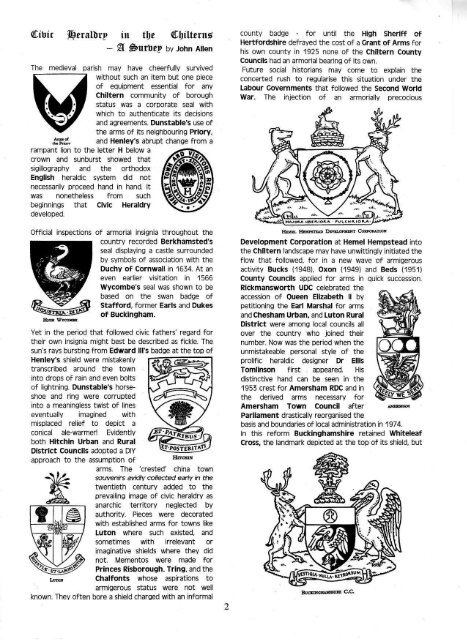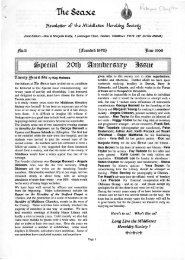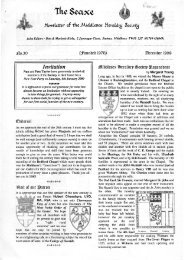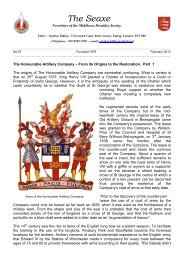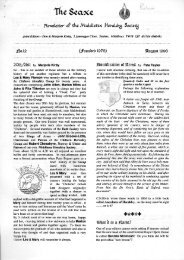The Seaxe - Middlesex Heraldry Society
The Seaxe - Middlesex Heraldry Society
The Seaxe - Middlesex Heraldry Society
You also want an ePaper? Increase the reach of your titles
YUMPU automatically turns print PDFs into web optimized ePapers that Google loves.
Civic <strong>Heraldry</strong> in the Chilterns<br />
- A Survey by John Allen<br />
<strong>The</strong> medieval parish may have cheerfully survived<br />
without such an item but one piece<br />
of equipment essential for any<br />
Chiltern community of borough<br />
status was a corporate seal with<br />
which to authenticate its decisions<br />
and agreements. Dunstable's use of<br />
the arms of its neighbouring Priory,<br />
and Henley's abrupt change from a<br />
rampant lion to the letter H below a<br />
crown and sunburst showed that<br />
sigillography and the orthodox<br />
English heraldic system did not<br />
necessarily proceed hand in hand. It<br />
was nonetheless from such<br />
beginnings that Civic <strong>Heraldry</strong><br />
developed.<br />
Official inspections of armorial insignia throughout the<br />
country recorded Berkhamsted's<br />
seal displaying a castle surrounded<br />
by symbols of association with the<br />
Duchy of Cornwall in 1634. At an<br />
even earlier visitation in 1566<br />
Wycombe's seal was shown to be<br />
based on the swan badge of<br />
Stafford, former Earls and Dukes<br />
of Buckingham.<br />
HIGH WYCOMBE<br />
Yet in the period that followed civic fathers' regard for<br />
their own insignia might best be described as fickle. <strong>The</strong><br />
sun's rays bursting from Edward Ill's badge at the top of<br />
Henley's shield were mistakenly<br />
transcribed around the town<br />
into drops of rain and even bolts<br />
of lightning. Dunstable's horseshoe<br />
and ring were corrupted<br />
into a meaningless twist of lines<br />
eventually imagined with<br />
misplaced relief to depict a<br />
conical ale-warmer! Evidently<br />
both Hitchin Urban and Rural<br />
District Councils adopted a DIY<br />
approach to the assumption of<br />
HITCHIN<br />
arms. <strong>The</strong> crested' china town<br />
souvenirs avidly collected early in the<br />
twentieth century added to the<br />
prevailing image of civic heraldry as<br />
anarchic territory neglected by<br />
authority. Pieces were decorated<br />
with established arms for towns like<br />
Luton where such existed, and<br />
sometimes with irrelevant or<br />
imaginative shields where they did<br />
not. Mementos were made for<br />
LUTON<br />
Princes Risborough. Tring, and the<br />
Chalfonts whose aspirations to<br />
armigerous status were not well<br />
known. <strong>The</strong>y often bore a shield charged with an informal<br />
2<br />
county badge - for until the High Sheriff of<br />
Hertfordshire defrayed the cost of a Grant of Arms for<br />
his own county in 1925 none of the Chiltern County<br />
Councils had an armorial bearing of its own.<br />
Future social historians may come to explain the<br />
concerted rush to regularise this situation under the<br />
Labour Governments that followed the Second World<br />
War. <strong>The</strong> injection of an armorially precocious<br />
HEMEL HEMPSTEAD DEVELOPMENT CORPORATION<br />
Development Corporation at Hemel Hempstead into<br />
the Chiltern landscape may have unwittingly initiated the<br />
flow that followed, for in a new wave of armigerous<br />
activity Bucks (1948), Oxon (1949) and Beds (1951)<br />
County Councils applied for arms in quick succession.<br />
Rickmansworth UDC celebrated the<br />
accession of Queen Elizabeth II by<br />
petitioning the Earl Marshal for arms<br />
and Chesham Urban, and Luton Rural<br />
District were among local councils all<br />
over the country who joined their<br />
number. Now was the period when the<br />
unmistakable personal style of the<br />
prolific heraldic designer Dr Ellis<br />
Tomlinson first appeared. His<br />
distinctive hand can be seen in the<br />
1953 crest for Amersham RDC and in<br />
the derived arms necessary for<br />
Amersham Town Council after AMERSHAM<br />
Parliament drastically reorganised the<br />
basis and boundaries of local administration in 1974.<br />
In this reform Buckinghamshire retained Whiteleaf<br />
Cross, the landmark depicted at the top of its shield, but<br />
BUCKINGHAMSHIRE C.C.


